SKY ISLANDS ADD DIVERSITY
The sky islands scattered throughout the Sonoran Desert help account for its surprising ecological diversity. One such “island” mountain rising from the desert plains is Mount Graham, which rises from the mesquite-studded Sonoran Desert to a height of more than 0,000 feet ( ,0 m). This means the peak has conditions more akin to Canada […]
Sky Islands Rise from Desert Seas
The basin and range geography that created all the deserts of North America, in the Sonoran created a chain of 10,000-foot-tall (3,048 m) mountains surrounded by low desert basins that help account for the extraordinary ecological diversity of the Sonoran Desert. One of the most striking mountains is the 7,730-foot-tall (2,356.10 m) Baboquivari in southern […]
Saguaros Nourish Civilizations
Saguaros also sustained desert-dwelling Indians. The Pima and Papago, now called the Tohono O'odham, relied heavily on the sweet, nutritious fruit of the saguaro. They dry-farmed corn, squash, and beans, channeling both winter and summer rains onto farmed terraces and stream meanders. Fortunately, the saguaro fruit offered a nutritional bounty perfectly timed between their twin […]

Sonoran Desert Arizona and Northern Mexico
T he towering, bristling, water-hoarding saguaro cactus cluster thickly across the desert corrugations of Saguaro National Monument in Arizona, brooding over a mystery. The defining plant of the Sonoran Desert, the largest of the saguaro are 200 years old, 50 feet high (15.24 m), and weigh eight tons. They dominate the park that occupies two […]

Origin of the Landform: Deserts
T he appearance and evolution of Earth's deserts offer deep insights into geology, history, evolution, climate, and the whole rich history of the planet. Although deserts now cover great swaths of Earth's surface along the broad, hot midsection of the planet, most modern deserts are new landscapes—the transformation of grasslands and woodlands into an austere […]
VALLEY OF THE DEAD
Barely 100 kilometers (62 mi.) from the highest peak in the contiguous United States, Mount Whitney in the Sierra Nevada, lies the lowest point in the western hemisphere in Death Valley, in this northern arm of the Mojave Desert, the valley floor descends to 86 meters (282 ft.) below sea level. The valley may not […]

HOW DESERTS FORM
The answer to the question “Why do deserts form?” seems obvious—sustained lack of rainfal—but he global and local climatic conditions that lead to such aridity are complex and an understanding of them helps explain such apparent anomalies as coastal deserts. Deserts are among some of the most alien, inhospitable landscapes on the planet. Some of […]
POLAR DESERTS
The term “desert” was once confined to hot, arid regions of the tropics and subtropics. However, the central place given to the absence or sparsity of vegetation in many definitions of the term has led to the development of the concept of the “cold desert”—a terrain in which low temperatures and physiological drought drastically inhibit […]
DINOSAURS OF THE DESERTS
Arid, rocky region with their lack of soil and plant cover are ideal for fossilhunting. Remains of any dinosaurs, prehishistoric mammals, and other long gone creatures are regularly discovered in modern deserts such as the Gobi the patagonian Desert, and the Kalahari. A major expedition of the 1920s visited the rocks there are far too […]
DESERT: INTRODUCTION
In the Western imagination the word “desert” most often evokes a landscape of endless gigantic sand dunes, dazzling white under a cloudless hot-blue sky and a blazing sun. This landscape of the imagination is likely to be empty—deserted—except, perhaps, for a caravan of nomads and camels that inches slowly across the horizon, or a lone […]

Desert and Tundra Biomes
DESERT BIOME The desert biome includes several formation classes that are transitional from grassland and savanna biomes into vegetation of the arid desert. Our map of the desert biome (Figure 9.28) recognizes two basic formation classes: semidesert and dry desert. Semidesert is a transitional formation class found in a wide latitude range—from the tropical zone to the midlatitude zone. It is […]
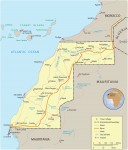
Western Sahara
POPULATION: 261,794 (2014) AREA: 97,000 sq. mi. (252,000 sq. km) LANGUAGES: Arabic (official); Berber dialects NATIONAL CURRENCY: Moroccan dirham PRINCIPAL RELIGION: Muslim CITIES: El-Aaiun (Laayoune), Cabo Bojador, Bu Craa, Smara (Semara), Ad Dakhla ANNUAL RAINFALL: Less than 2 in. (50 mm) ECONOMY: GDP per capita: N/A PRINCIPAL PRODUCTS AND EXPORTS: Agricultural: fish Manufacturing: handicrafts Mining: phosphates GOVERNMENT: Claimed and administered by Morocco since 1979, […]

Sahara Desert
Stretching across northern Africa from the Atlantic Ocean in the west to the Red Sea in the east, the Sahara is the world's largest desert. It forms a natural barrier between two very different geographic and cultural regions: NORTH AFRICA, with its Arab-influenced Mediterranean culture; and sub-Saharan Africa, where indigenous African culture is dominant. Yet for centuries people have […]

Kalahari Desert
The Kalahari Desert is a large, sandy plain in southern Africa with forested regions in its northern reaches. Really a semidesert or dry savanna rather than a true desert, the Kalahari measures about 1,000 miles from north to south and 600 miles from east to west at its broadest points. About 100,000 KHOISAN people and approximately 1.5 million BANTU-speaking people […]
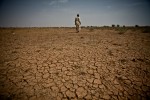
Deserts and Drought
Africa contains two desert regions, the SAHARA DESERT in the north and the Namib-Kalahari region in the southwest. Traditionally, very few people have lived in Africa's deserts. However, some groups inhabit the semiarid lands bordering deserts—areas that are somewhat wetter than the desert. The well-being of these people depends on rainfall, which varies greatly from year to year. With an […]

Western Sahara
Area 102,703 square mi (266,000 square km) Population 261,794 (2014) Capital None; occupied by Morocco Highest Point 2,700 ft (823 m) Lowest Point -180 ft (-55 m) GDP per capita na Primary Natural Resources phosphate. AS OF 2005, WESTERN SAHARA, formerly called Spanish Sahara, was officially occupied by MOROCCO. Western Sahara is one of the most inhospitable […]

Thar Desert
THE THAR DESERT, often called the Indian Desert, extends for about 400 mi (644 km) from southwest to northeast and has a maximum width of about 225 mi (362 km). The desert is limited to the south by the Great Rann of Cutch. To the west lies the valley-plain of the INDUS RIVER and to the northwest that of the […]
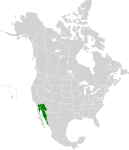
Sonoran Desert
THE SONORAN DESERT, an arid region of western North America, covers an area of 120,000 square mi (311,000 square km) in southwestern ARIZONA and southeastern CALIFORNIA, most of Baja California, and the western half of the state of Sonora, MEXICO. It is one of the largest and hottest deserts in North America and has two primary subdivisions, the Colorado and Yuma […]

Sahara Desert
THE SAHARA IS THE world's largest desert. Covering about 3,320,000 square mi (8,600,000 square km) it is roughly the size of the UNITED STATES. It extends across the whole of North Africa from the ATLANTIC OCEAN to the RED SEA, a distance of more than 3,500 mi (5,630 km). It stretches south for at least 1,200 mi (1,930 km). The Sahara […]

Rub’ al-Khali
THE RUB' AL-KHALI (Arabic for “Empty Quarter”) is located in the southern part of the Arabian Desert. The Al-Murrah Bedouin, who roam its southern edges call it the ar-Ramlah, the “sand.” It covers an area of about 250,000 square mi (647,500 square km). It is somewhat smaller than TEXAS or about as large as FRANCE together with BELGIUM and Holland. Most […]

Negev Desert
THE NEGEV IS A part of the Saharo-Arabian desert belt running from the ATLANTIC OCEAN across the SAHARA and Arabia to the Sind desert of INDIA's Indus Valley. The Negev, also spelled Negeb, means both “the southland” and “dry.” Negev is derived from the Hebrew verbal root n-g-v meaning “to dry.” The Ha-Negev (Hebrew) covers […]
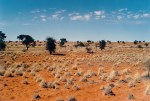
Kalahari Desert
THE NAME KALAHARI is derived from the Tswana word Kgalagadi, meaning “the great thirst.” The Kalahari Desert, an arid region on the interior plateau of southern Africa, covers area in central and southwestern BOTSWANA, parts of west-central SOUTH AFRICA and eastern NAMIBIA, encompassing an area of about 100,000 square mi (260,000 square km). The Kalahari […]
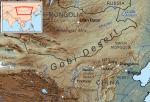
Gobi Desert
THE 650,000-square-mi (1,600,000-square-km) Gobi is the largest desert in CHINA and MONGOLIA; both the Taklamakan Desert (in XINJIANG) and the Changtang Desert (in TIBET and Qinghai) are only half the size. Only the SAHARA is bigger than the Gobi among the world's deserts. The Gobi separates the Republic of Mongolia from the province of Inner […]

desertification
SINCE THE mid-1970s, the United Nations (UN) has considered desertification a significant environmental problem involving high economic, societal, and human costs. The UN's Conference on Desertification, held in 1977, outlined an action plan over a 20-year period that, unfortunately, did little to change the course of desertification. The definition of desertification itself is controversial. In […]
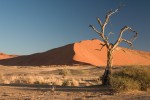
desert
THERE IS A TENDENCY, in popular opinion and some public policy, to view deserts dismissively as unproductive wastelands. The 14th edition of the Encyclopedia Britannica made the case with exuberant eloquence: “Desert, a term popularly applied to any environmentally extreme, deserted, desolate, uninhabitable waste area.” While they are indeed less productive of biomass than other […]